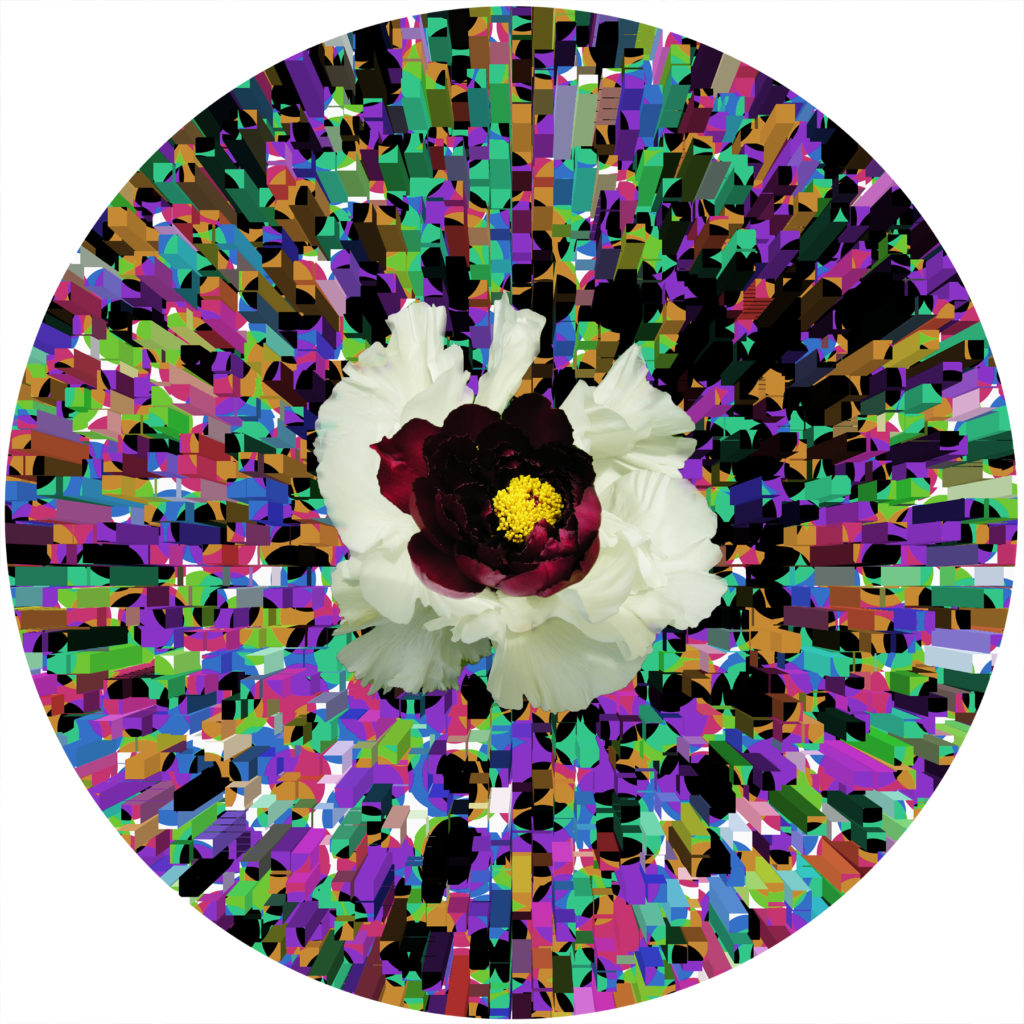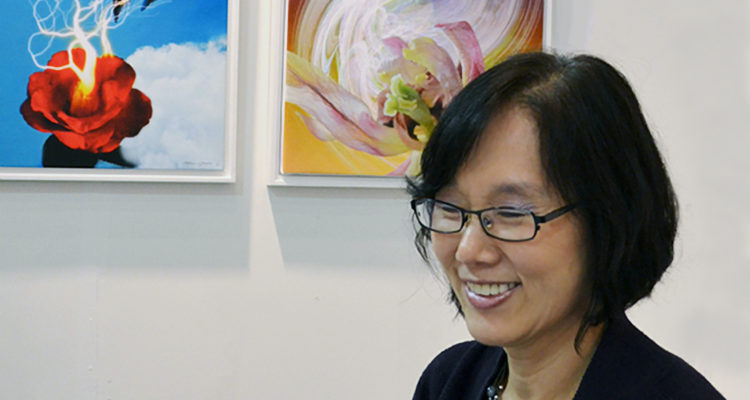“I believe that hope is born out of adversity…”
Paul Zimmerman in conversation with Mae Jeon
Paul Zimmerman: Flowers are always present in your work. How did you develop interest in this subject?
Mae Jeon: My love of flowers came to me naturally from an early age. While growing up in Seoul, there were all kinds of flowers and fruit trees in the front yard, and my mother always displayed flower arrangements in the living room. During my experimenting period with the digital medium, I noticed a red tulip with sharp tooth edges along its petals. The flower embodied the anguish I was feeling at the time. So, I decided to photograph the flower and create a simulated background to express my emotions. The artwork “unceasing anguish” was the invitation piece of my first digital art solo show. This piece was the beginning of creating floral art with digital abstraction. I thought that flowers have the same nature as human beings: fragile beauty, delicate character, mystical structure, and a seasonal life span. I have found a flower is also the perfect subject for the emotional and spiritual topic that I am interested in expressing through my digital work. I have continued creating floral art ever since.
PZ: What is your creative process?
MJ: My art process often starts from the image that I capture during my exploration within the digital space. From there I incorporate the flower image that reflects the topic I aim to express.
I often use abstract image generating software for the background of my art. But sometimes, I start work from digital paintbrush strokes as a background vile. Then I choose flower images from my own photographic image files. I might say this process is like casting an actress for the drama. Then, I place the flower image into the simulated abstract background in the Photoshop to combine and convey the meaning of often spiritual vocabulary. In the final stage of work, I usually reforming images with filter effects or apply brush paint until I satisfy my creative goal. However, occasionally I encounter a flower image that fills me with inspiration. In those cases, I start with the flower image for a new piece and then create a background image to complete the work, contrary to the process mentioned above.
PZ: How do you find the balance between technology and artistic expression?
MJ: I am grateful for the current advanced digital technology that enables me to achieve a digital art career. I find that the digital medium enables me to continually find new and creative ways for artistic expression. However, technology does not make the art itself apart from the soul and mind, just as a musical instrument cannot play itself. The spiritual concept that I intend to convey is always guiding my artistic process.
PZ: Has your practice changed over time?
MJ: I started doing digital fine art in the early 2000s. At the time, most galleries did not accept digital work as fine art. Then, as the digital printer and printing material was developed to archival quality, the many galleries started accepting digital artwork in 35mm slide submissions. When I had show in the 2007 Art Expo, my digital works I printed were up to 13×19 inches. Then I saw the Epson Pro Stylus printer for the 24inch print at the promotion booth and I purchased it. I then started to print my digital artwork on larger fine art paper and canvas in my studio, while also matting and stretched framing artwork myself for many years to follow. Then at the 2014 Spectrum art fair, I noticed many artists using metal prints. I found that they were beautiful and affordable from a commercial printing lab. In 2015 solo show, all my digital work I have used metal prints and have continued to do so since.

PZ: Do you have any particular goal in mind when your start a new piece?
MJ: I start each new piece with a common creative goal, which is to make art in the highest artistic quality while using the best of what current digital technology offers. I do aim for a new piece to brighten the space where my artwork resides and enlighten the hearts of viewers with hope in life. My goal is to convey messages of hope by portraying the frailty and resilience of life.
PZ: How did you become interested in art?
MJ: I started painting watercolor at age 12 in junior high school with a friend who also loved art. We started taking watercolor painting lessons from an art tutor at the park.
When I was 14, I received a set of world master artist book series from my father who he bought from a business trip in Japan. I was fascinated by each artist’s work and looked over the book daily. I especially loved the paintings of Degas, Monet. I copied many artworks from the book with soft pastels. And I dreamed of being a great fine artist.
I joined the student artist club in high school. Daily after school hours I painted watercolor and charcoal drawings at the school art workshop. At home I also painted still life, so my mother made the painting art corner in our living room. And my artwork piled up, my parents allowed me to use the barn space as my art studio. I painted numerous oil paintings for several years until I left home to get married. I majored in graphic design in college and I also painted oil painting at a private artist workshop and entered the national art contest with large oil paintings. I had solo shows twice with mixed medium in Seoul, and in Tokyo.
PZ: How would you describe your style?
MJ: My artwork reflects my Christian spiritual journey. I would say that my work is the transformation of spiritual ideas and divine vocabularies into pictorial images by combining floral subjects and digital technology. In each image I convey a message of hope by portraying the frailty and resilience of our soul and life.
PZ: Which artists are you most influenced by?
MJ: After college, I worked as an internship designer at the Shiseido cosmetic company in Tokyo. I visited gallery shows almost daily during lunch hours. There I saw various surreal artworks in the galleries. And I was impressed with the surreal artist, Kozo Mio. I was captivated by his work and revisited the show several more times. It was a surreal image of a person with a square space of large oil paintings. I still have his show catalog and his surreal artwork still influences my art creation to this day.
PZ: What are you working on now?
MJ: I have been working on circular metal prints for future shows, although I am not planning for a show in the coming year. I have also been working to expand subjects in the digital medium. Recently, I submitted a work of non floral subject to the CFA magazine contest and was chosen for the Artistic Excellence Award. I am also working on a book project called ‘Flowers for Monet’ for a German publisher.
PZ: Does this pandemic impact your work and sensibility?
MJ: The pandemic has certainly affected both my work and sensibility in many ways. I shared my artwork in two exhibitions during January and March of 2020. I participated in Staten Island’s 1st local artist juried 4-month show ‘Dawn of a New Decade’ from January to April. The show was successful but temporarily closed in March and the reopen plan is when the pandemic is over. I also participated in a Three-Woman exhibit in March, at the National Artist of Women Association, NYC gallery. The show was closed the day after the opening reception and the gallery was locked down for six months with my exhibited work.
This unthinkable situation reminds me that our lives are fragile and that each moment is precious. I’ve been reflecting on the suffering and isolation brought on by the pandemic and am inspired to create artwork that expresses divine love and hope in the midst of darkness. I believe that hope is born out of adversity and I am impassioned to continually create during these difficult times.
